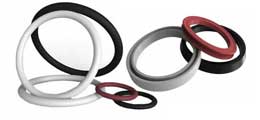
Seals are an essential component of many machines and mechanically driven devices. Consisting of O-rings, gaskets and other molded or extruded products, they live up to their namesake by “sealing” a mating surface. Most machines aren’t made of a single part. Rather, they feature multiple parts. The area where two or more parts meet may require a seal to protect against leaks.
It’s not uncommon for machines to feature liquid- or gas-filled passages. Liquids like oil or coolant may flow through a machine, or combustion gases may travel out of a machine. With a seal, liquid and gas will remain confined to the appropriate passage. These substances can travel through the machine’s parts without leaking. There are spring-energized seals, however, that are particularly effective at preventing leaks
An Introduction to Spring-Energized Seals
Spring-energized seals are characterized by their ability to store mechanical energy. All springs, of course, can store mechanical energy. Spring are devices that, in some way, store mechanical energy. Some of them store mechanical energy by becoming shorter when exposed to a load on the side. Others store mechanical energy by stretching and become longer when pulled from the side. Spring-energized seals, on the other hand, store mechanical energy by compressing.
Benefits of Spring-Energized Seals
When conventional seals fail to create a leak-proof mating surface, spring-energized seals may be the answer. They can withstand more heat and pressure than their conventional counterparts, making them a popular alternative for machinery-related sealing applications.
Seals are commonly exposed to heat and pressure. If oil or coolant flows through a machine, it will likely heat up. As the oil or coolant heats up, it will expand. Expansion such as this will then create pressure within the passage through which the oil or coolant flows. Assuming there’s a seal in place, it too will be exposed to this heat and pressure.
Spring-energized seals are designed to withstand heat and pressure. When exposed to hot, pressured oil or coolant — or hot and pressurized gases — they’ll compress. They’ll essentially become smaller and more compact. Spring-energized seals will store the mechanical energy created by the heat and pressure, allowing them to maintain a leak-proof mating surface.
In Conclusion
There are different types of seals. Spring-energized seals are defined by their ability to store mechanical energy. Some of them consist of O-rings, whereas others consist of gaskets. Regardless, they can all store mechanical energy.
